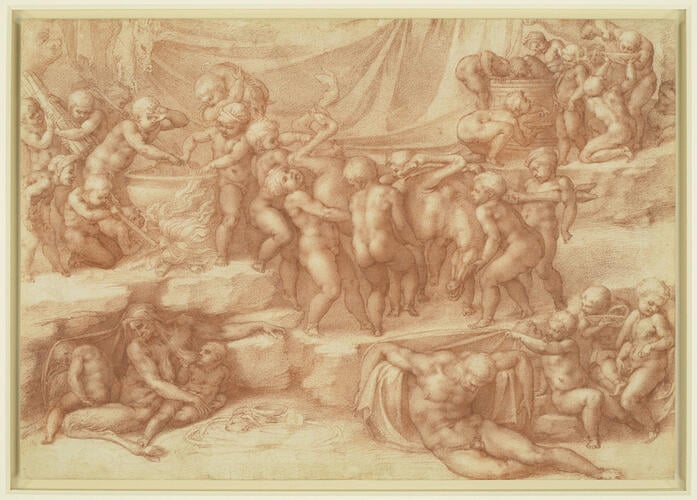-
1 of 253523 objects
A Children's Bacchanal 1533
Red chalk, two shades | 27.4 x 38.8 cm (sheet of paper) | RCIN 912777
-
A highly finished 'presentation drawing' of a bacchic scene. On a rocky staging on several levels are five distinct groups. At the centre, seven children struggle to carry the corpse of a deer towards a cauldron. At upper left, their companions stoke the fire and stir the pot, one bearing a small boar on his shoulders; a boar’s head and a hare hang behind. At upper right, children drink from a wine vat; one appears to be clambering in, while another urinates into a wine bowl that will soon be offered to his friend. At lower left an aged satyress, with goat's legs, suckles a child, another asleep in her lap. At lower right a naked man slumps in what may be a drunken stupor, while a child lifts a drape from him.
The drawing was identified by Michelangelo's biographer Giorgio Vasari (Lives of the Artists, 1550 and 1568) as among those made by the artist as gifts for the young Roman nobleman Tommaso de’ Cavalieri; the others are Tityus (RCIN 912771), The Fall of Phaeton (912766), and a Ganymede (now lost but recorded in copies, including 913036). The Bacchanal was the last of those four ‘presentation drawings’, and can be dated to the autumn of 1533. Some of the figures are copied in a drawing (in the Ashmolean Museum, Oxford, WA1846.131) by Raffaello da Montelupo, who entered Michelangelo’s service in Florence in late summer 1533; Michelangelo returned from Florence to Rome, for the last time, in late October that year. It is also the most highly finished of the four, perhaps of all Michelangelo’s drawings, and in a pristine state of preservation that allows us to appreciate the deliberate contrast between the stippled modelling of the figures and the more broadly worked setting.
Unlike the other three drawings for Cavalieri, this is not an illustration of a specific literary subject, although the general meaning in Neoplatonic philosophy seems clear enough. The children represent the soul in the absence of reason, intellect or divine love, driven solely by natural urges and acting in an animal-like manner. Of the two adults present, neither is fully human: one is half-goat, and the other is apparently overcome by drink (drunkenness was used by Neoplatonists as a metaphor for the unknowing captivity of the soul by the body, and as such was portrayed by Michelangelo in his early sculpture of Bacchus, in the Bargello, Florence). Indeed the four drawings that Michelangelo executed for Cavalieri can be seen in Neoplatonic terms as a coherent group, expressed by Erwin Panofsky thus: ‘If the Ganymede symbolises the enraptured ascension of the Mind, and if again the Punishment of Tityus and the Fall of Phaethon exemplify the fate of those who are uncapable of controlling their sensuality and imagination, the Children’s Bacchanal, which is entirely devoid of amorous tension, might thus be the image of a still lower sphere: the sphere of a purely vegetative life which is as much beneath specifically human dignity as the Mind is above specifically human limitations’ (Studies in Iconology, p. 223).
The drawing’s sources range from Roman sarcophagus reliefs of playing putti and the Death of Meleager to the works of Donatello and Mantegna. Many of these sources are funerary in nature or related to Bacchic rites – not in the simple sense of revelry, but the pagan rituals of sacrifice and renewal as they were understood in the Renaissance; one of Michelangelo’s poems of the period speaks of attaining new life ‘as a serpent sloughs on a stone, [that] I might through death change my condition’ (‘come serpe al sasso si discoglia, / pur per morte potria cangiar mie stato’. Ryan, The Poems of Michelangelo, pp. 90–91). The central group of the deer being carried to the pot is derived from Raphael’s Entombment (Galleria Borghese, Rome); and a sketch by Michelangelo for the Bacchanal in the Musée Bonnat, Bayonne, bears on the other side of the sheet a closely related composition of a Deposition or Entombment in which a group of figures lower to the ground (or begin to lift) the body of Christ, a mirror image of the stupefied man here. Michelangelo intuited the close relationship between the pagan rituals of death and renewal and the redemption of humanity through Christ’s sacrifice and resurrection, and the chalice and animal’s head in the foreground suggest both Christian and pagan sacrifice. This was the period of Michelangelo’s intensive explorations of the Resurrection (see 912767-8), but that triumphant rebirth of Christ had to be preceded by a descent into the lowest zones, and that is, at its heart, what we see here.
The drawing was reproduced in engravings from an early date: by Enea Vico, 1546 (RCIN 830724); by Nicolas Beatrizet (830381); and by an anonymous engraver, published by Antonio Lafreri, 1553.Provenance
Tommaso de' Cavalieri; Emilio de' Cavalieri, from 1587; Cardinal Odoardo Farnese, by 1602. Entry to Royal Collection unknown, but probably acquired early in the reign of George III, c.1760. Listed in George III's 'Inventory A', c. 1800-20, p. 45, 'Mich: Angelo Buonaroti' / Tom. II (c. 1802): '3. Several Boys carrying a dead Monster, One with a Pig; some boiling a Caldron, other in Groupe in the foreground drinking; A female Satyr and two Children; one sucking her lank Breast, the other uncovering an Old Man a Sleep - perhaps the Emblem of Night - the subject very obscure, but the Drawing very Capital...Red Chalk.').
-
Medium and techniques
Red chalk, two shades
Measurements
27.4 x 38.8 cm (sheet of paper)
Category
Object type(s)
Other number(s)
Michelangelo / Charles de Tolnay. 1969-71. 5 v. – Tolnay 338Alternative title(s)
A Bacchanal of Children
